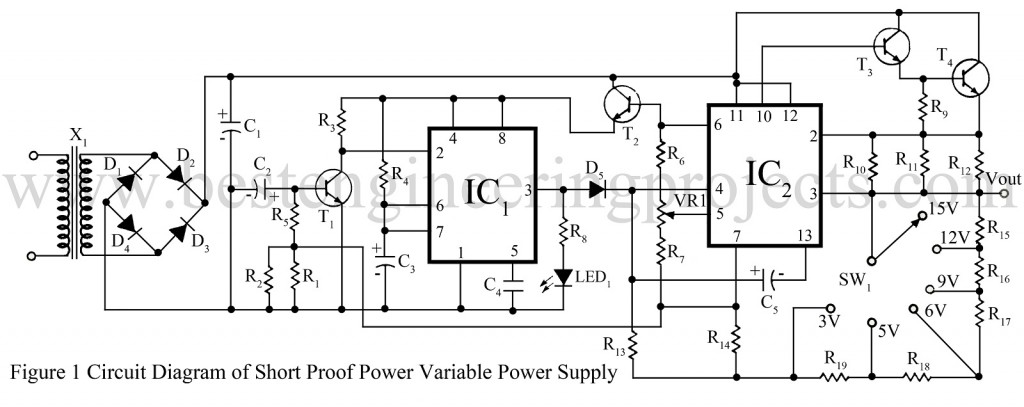This is a complete short-proof variable power supply circuit that gives 3V, 5V, 6V, 9V, 12V, and 15V output voltage and a maximum output current of 700mA. The unique feature of the circuit short proof variable power supply is that the power dissipated is reduced to a negligible level during short-circuit or overload conditions. In conventional power supplies, the maximum rated current continuously flows through the load under overload conditions. This may damage the power supply and the load.
Working of Short Proof Variable Power Supply Circuit
The circuit short-proof variable power supply ‘plays cool’ under overload conditions. Whenever the output current exceeds 800mA, the circuit is turned off and after a second, it is turned on automatically. If the overload condition persists, the circuit is turned off again and the cycle is repeated until the overload is removed.
Since the pass transistor is cut-off most of the time, the power dissipated during overload conditions is negligible, thereby protecting the power transistor and the load. The LED starts glowing during an overload condition.
Circuit Description of Short-Proof Variable Power Supply Circuit
The heart of the circuit’s short-proof variable power supply is an LM723 voltage regulator. A reference voltage of 7.15V appears at the IC’s pin 6. This is tapped and given to the non-inverting input (pin 5) through resistors R6, R7, and VR1. The output voltage can be selected by switch SW1.
Under normal conditions, pin 3 of IC1 is low. However, during overload conditions, the voltage across R1 and R2 exceeds 0.6V, and transistor T1 starts conducting. This makes pin 2 of IC1 negative and triggers the monostable multivibrator. Thus, the output of IC1 becomes high. The voltage at inverting input (pin 4) of IC2 becomes more than the voltage at the non-inverting input and the output voltage is brought down to zero. However, after a second, pin 3 of IC1 again goes low. If the short-circuit persists, the cycle is repeated.
C2 and R5 delay the switching of transistor T1. Narrow spikes of duration less than 10ms are passed through the circuit and are limited to 1.8A by resistors R10, R11, and R12. Regulated 6,6V is supplied to IC1 through transistors and must be mounted on suitable heatsinks.
For calibration, set switch SW1 at 5V position and adjust VR1 to get 5V at the output. Now change the position of SW1 and check the output voltage. Similarly, calibrate for all positions of the switch. Now short-circuit the output. The LED should start glowing (to indicate overload) if the circuit is correctly assembled.
PARTS LIST OF SHORT PROOF VARIABLE POWER SUPPLY CIRCUIT
|
Resistor (all ¼-watt, ± 5% Carbon) |
|
R1, R2 = 1.5 Ω/1W R3 = 10 KΩ R4 = 100 KΩ R5, R13 = 2.2 KΩ R6 = 5.6 KΩ R7 = 3.9 KΩ R8 = 560 Ω R9, R14 – R17 = 1 KΩ R10 – R12 = 1 Ω/0.5W R18 = 330 Ω R19 = 680 Ω VR1 = 2.2 KΩ |
|
Capacitors |
|
C1 = 1000 µF, 40V (Electrolytic Capacitor) C2 = 2.2 µF, 12V (Electrolytic Capacitor) C3 = 10 µF, 12V (Electrolytic Capacitor) C4 = 0.01 µF (Ceramic Disc) C5 = 1 µF, 12V (Electrolytic Capacitor) |
|
Semiconductors |
|
IC1 = NE555 (Timer IC) IC2 = LM723 (Voltage Regulator IC) T1 = BC148B (General Purpose NPN Silicon Transistor) T2, T3 = HL100B (Medium Power NPN Silicon Transistor) T4 = 2N3055 (High Power NPN Transistor) D1 – D4 = 1N4002 (General Purpose Rectifier Diode) D5 = 1N4148 (Switching Diode) LED |
|
Miscellaneous |
|
X1 = 230V AC primary 0-18V, 1 AMP secondary transformer SW1 = 1-pole 6-way switch |

Hello am doing this project as my diploma final year project, but I found it hard to implement I really need your help.
-Khaleed, TANZANIA
Please elaborate the issue you are facing.